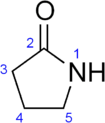2-Pyrrolidone
| |||
| Names | |||
|---|---|---|---|
| Preferred IUPAC name
Pyrrolidin-2-one | |||
| Other names
2-Pyrrolidone 2-Pyrrolidinone | |||
| Identifiers | |||
| 3D model (JSmol) |
|||
| ChEBI | |||
| ChemSpider | |||
| ECHA InfoCard | 100.009.531 | ||
| EC Number | 210-483-1 | ||
| PubChem CID |
|||
| UNII | |||
| |||
| |||
| Properties | |||
| C4H7NO | |||
| Molar mass | 85.11 g·mol−1 | ||
| Density | 1.116 g/cm3[1] | ||
| Melting point | 25 °C (77 °F; 298 K)[2] | ||
| Boiling point | 245 °C (473 °F; 518 K)[1] | ||
| Hazards | |||
| Safety data sheet | ScienceLab.com | ||
| NFPA 704 | |||
| Flash point | 129 °C (264 °F) (open cup)[1] 138 °C (280 °F) (closed cup)[2] | ||
| Except where otherwise noted, data are given for materials in their standard state (at 25 °C [77 °F], 100 kPa). | |||
| | |||
| Infobox references | |||
2-Pyrrolidone is an organic compound consisting of a 5-membered lactam, making it the simplest γ-lactam. It is a colorless liquid that is miscible with water and most common organic solvents.[3]
It is produced industrially by treating butyrolactone with ammonia. Alternative routes include the partial hydrogenation of succinimide and the carbonylation of allylamine with methyl amine. 2-Pyrrolidone is an intermediate in the production of vinylpyrrolidone and the drug piracetam.[3]
Uses
A variety of pharmaceutical drugs are 2-pyrrolidone derivatives including:
2-pyrrolidone is used in inkjet cartridges.[4]
Safety
2-pyrrolidone is an eye irritant.[4]
See also
- N-Methylpyrrolidone (NMP)
- N-Vinylpyrrolidone (NVP)
References
- 1 2 3 Merck Index, 11th Edition, 8027
- 1 2 Record in the GESTIS Substance Database of the Institute for Occupational Safety and Health
- 1 2 Albrecht Ludwig Harreus, R. Backes, J.-O. Eichler, R. Feuerhake, C. Jäkel, U. Mahn, R. Pinkos, R. Vogelsang"2-Pyrrolidone" in Ullmann's Encyclopedia of Industrial Chemistry, Wiley-VCH, 2011, Weinheim. doi:10.1002/14356007.a22_457.pub2
- 1 2 "Safety Data Sheet" (PDF). HP website. HP. 7 October 2014. Retrieved 11 October 2014.
External links
- Pyrrolidinones at the US National Library of Medicine Medical Subject Headings (MeSH)
This article is issued from
Wikipedia.
The text is licensed under Creative Commons - Attribution - Sharealike.
Additional terms may apply for the media files.


